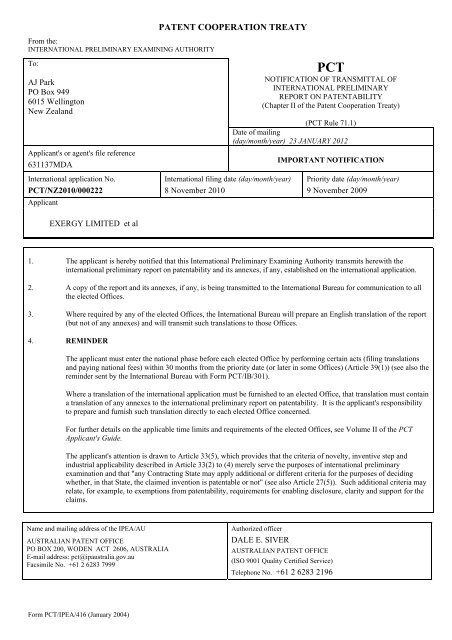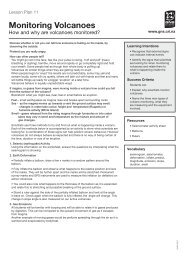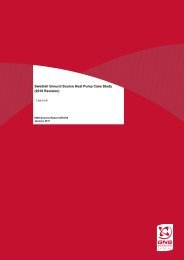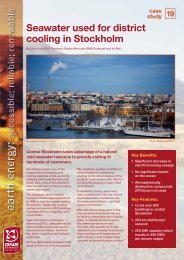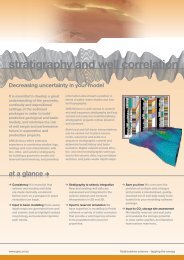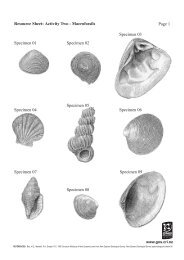PATENT COOPERATION TREATY
PATENT COOPERATION TREATY
PATENT COOPERATION TREATY
Create successful ePaper yourself
Turn your PDF publications into a flip-book with our unique Google optimized e-Paper software.
From the:<br />
INTERNATIONAL PRELIMINARY EXAMINING AUTHORITY<br />
To:<br />
AJ Park<br />
PO Box 949<br />
6015 Wellington<br />
New Zealand<br />
Applicant's or agent's file reference<br />
631137MDA<br />
International application No.<br />
PCT/NZ2010/000222<br />
Applicant<br />
EXERGY LIMITED et al<br />
Form PCT/IPEA/416 (January 2004)<br />
<strong>PATENT</strong> <strong>COOPERATION</strong> <strong>TREATY</strong><br />
International filing date (day/month/year)<br />
8 November 2010<br />
PCT<br />
NOTIFICATION OF TRANSMITTAL OF<br />
INTERNATIONAL PRELIMINARY<br />
REPORT ON <strong>PATENT</strong>ABILITY<br />
(Chapter II of the Patent Cooperation Treaty)<br />
(PCT Rule 71.1)<br />
Date of mailing<br />
(day/month/year) 23 JANUARY 2012<br />
IMPORTANT NOTIFICATION<br />
Priority date (day/month/year)<br />
9 November 2009<br />
1. The applicant is hereby notified that this International Preliminary Examining Authority transmits herewith the<br />
international preliminary report on patentability and its annexes, if any, established on the international application.<br />
2. A copy of the report and its annexes, if any, is being transmitted to the International Bureau for communication to all<br />
the elected Offices.<br />
3. Where required by any of the elected Offices, the International Bureau will prepare an English translation of the report<br />
(but not of any annexes) and will transmit such translations to those Offices.<br />
4. REMINDER<br />
The applicant must enter the national phase before each elected Office by performing certain acts (filing translations<br />
and paying national fees) within 30 months from the priority date (or later in some Offices) (Article 39(1)) (see also the<br />
reminder sent by the International Bureau with Form PCT/IB/301).<br />
Where a translation of the international application must be furnished to an elected Office, that translation must contain<br />
a translation of any annexes to the international preliminary report on patentability. It is the applicant's responsibility<br />
to prepare and furnish such translation directly to each elected Office concerned.<br />
For further details on the applicable time limits and requirements of the elected Offices, see Volume II of the PCT<br />
Applicant's Guide.<br />
The applicant's attention is drawn to Article 33(5), which provides that the criteria of novelty, inventive step and<br />
industrial applicability described in Article 33(2) to (4) merely serve the purposes of international preliminary<br />
examination and that "any Contracting State may apply additional or different criteria for the purposes of deciding<br />
whether, in that State, the claimed invention is patentable or not" (see also Article 27(5)). Such additional criteria may<br />
relate, for example, to exemptions from patentability, requirements for enabling disclosure, clarity and support for the<br />
claims.<br />
Name and mailing address of the IPEA/AU<br />
AUSTRALIAN <strong>PATENT</strong> OFFICE<br />
PO BOX 200, WODEN ACT 2606, AUSTRALIA<br />
E-mail address: pct@ipaustralia.gov.au<br />
Facsimile No. +61 2 6283 7999<br />
Authorized officer<br />
DALE E. SIVER<br />
AUSTRALIAN <strong>PATENT</strong> OFFICE<br />
(ISO 9001 Quality Certified Service)<br />
Telephone No. +61 2 6283 2196
Applicant's or agent's file reference<br />
631137MDA<br />
<strong>PATENT</strong> <strong>COOPERATION</strong> <strong>TREATY</strong><br />
PCT<br />
INTERNATIONAL PRELIMINARY REPORT ON <strong>PATENT</strong>ABILITY<br />
(Chapter II of the Patent Cooperation Treaty)<br />
(PCT Article 36 and Rule 70)<br />
Form PCT/IPEA/409 (Cover sheet) (July 2011)<br />
FOR FURTHER ACTION See Form PCT/IPEA/416<br />
International application No. International filing date (day/month/year) Priority date (day/month/year)<br />
PCT/NZ2010/000222 8 November 2010 9 November 2009<br />
International Patent Classification (IPC) or national classification and IPC<br />
Int. Cl. G06F 11/30 (2006.01) F02B 43/02 (2006.01) G05B 6/05 (2006.01) F01D 17/00 (2006.01)<br />
F22B 35/18 (2006.01) G06F 17/13 (2006.01) F01K 13/02 (2006.01)G05B 1/11 (2006.01)<br />
Applicant<br />
EXERGY LIMITED et al<br />
1. This report is the international preliminary examination report, established by this International Preliminary Examining<br />
Authority under Article 35 and transmitted to the applicant according to Article 36.<br />
2. This REPORT consists of a total of 4 sheets, including this cover sheet.<br />
3. This report is also accompanied by ANNEXES, comprising:<br />
a. X (sent to the applicant and to the International Bureau) a total of 6 sheets, as follows:<br />
X sheets of the description, claims and/or drawings which have been amended and/or sheets containing rectifications<br />
authorized by this Authority, unless those sheets were superseded or cancelled, and any accompanying letters (see<br />
Rules 46.5, 66.8, 70.16, 91.2, and Section 607 of the Administrative Instructions).<br />
sheets containing rectifications not taken into account by this Authority because they were not available at the<br />
time when this Authority began to draw up this report, and any accompanying letters (Rules 66.4bis, 70.2(e),<br />
70.16 and 91.2).<br />
Superseded sheets and any accompanying letters, where this Authority either considers that the superseding sheets<br />
contain an amendment that goes beyond the disclosure in the international application as filed, or the superseding<br />
sheets were not accompanied by a letter indicating the basis for the amendments in the application filed, as<br />
indicated in item 4 of Box No. I and the Supplemental Box (see Rule 70.16(b)).<br />
b. (sent to the International Bureau only) a total of (indicate type and number of electronic carrier(s)) , containing<br />
a sequence listing, in electronic form only, as indicated in the Supplemental Box Relating to Sequence Listing (see<br />
paragraph 3bis of Annex C of the Administrative Instructions).<br />
4. This report contains indications relating to the following items:<br />
X Box No. I Basis of the report<br />
Box No. II Priority<br />
Box No. III Non-establishment of opinion with regard to novelty, inventive step and industrial applicability<br />
Box No. IV Lack of unity of invention<br />
X Box No. V Reasoned statement under Article 35(2) with regard to novelty, inventive step and industrial<br />
applicability; citations and explanations supporting such statement<br />
Box No. VI Certain documents cited<br />
Box No. VII Certain defects in the international application<br />
Box No. VIII Certain observations on the international application<br />
Date of submission of the demand Date of completion of this report<br />
27 July 2011 11 January 2012<br />
Name and mailing address of the IPEA/AU<br />
Authorized Officer<br />
AUSTRALIAN <strong>PATENT</strong> OFFICE<br />
DALE E. SIVER<br />
PO BOX 200, WODEN ACT 2606, AUSTRALIA<br />
AUSTRALIAN <strong>PATENT</strong> OFFICE<br />
E-mail address: pct@ipaustralia.gov.au<br />
Facsimile No. +61 2 6283 7999<br />
(ISO 9001 Quality Certified Service)<br />
Telephone No. +61 2 6283 2196
INTERNATIONAL PRELIMINARY REPORT ON <strong>PATENT</strong>ABILITY International application No.<br />
Box No. I Basis of the report<br />
1. With regard to the language, this report is based on:<br />
X<br />
The international application in the language in which it was filed<br />
Form PCT/IPEA/409 (Box No. I) (July 2011)<br />
PCT/NZ2010/000222<br />
A translation of the international application into<br />
translation furnished for the purposes of:<br />
, which is the language of a<br />
international search (under Rules 12.3(a) and 23.1 (b)).<br />
publication of the international application (under Rule 12.4(a)).<br />
international preliminary examination (Rules 55.2(a) and/or 55.3(a) and (b)).<br />
2. With regard to the elements of the international application, this report is based on (replacement sheets which have been<br />
furnished to the receiving Office in response to an invitation under Article 14 are referred to in this report as "originally<br />
filed" and are not annexed to this report):<br />
the international application as originally filed/furnished<br />
X the description:<br />
pages 1-21 as originally filed/furnished<br />
pages* received by this Authority on with the letter of<br />
pages* received by this Authority on with the letter of<br />
X the claims:<br />
pages as originally filed/furnished<br />
pages* as amended (together with any statement) under Article 19<br />
pages* 22-26 received by this Authority on 13 December 2011 with the letter of 13 December 2011<br />
pages* received by this Authority on with the letter of<br />
X the drawings:<br />
pages 1/5 to 5/5 as originally filed/furnished<br />
pages* received by this Authority on with the letter of<br />
pages* received by this Authority on with the letter of<br />
a sequence listing - see Supplemental Box Relating to Sequence Listing.<br />
3. The amendments have resulted in the cancellation of:<br />
the description, pages<br />
the claims, Nos.<br />
the drawings, sheets/figs<br />
the sequence listing (specify):<br />
4. This report has been established as if (some of) the amendments annexed to this report and listed below had not been<br />
made, since either they are considered to go beyond the disclosure as filed, or they were not accompanied by a letter<br />
indicating the basis for the amendments in the application as filed, as indicated in the Supplemental Box (Rules 70.2(c)<br />
and (c-bis)):<br />
the description, pages<br />
the claims, Nos.<br />
the drawings, sheets/figs<br />
the sequence listing (specify):<br />
5. This report has been established:<br />
6.<br />
taking into account the rectification of an obvious mistake authorized by or notified to this Authority under<br />
Rule 91 (Rules 66.1(d-bis) and 70.2(e)).<br />
without taking into account the rectification of an obvious mistake authorized by or notified to this Authority<br />
under Rule 91 (Rules 66.4bis and 70.2(e)).<br />
Supplementary international search report(s) from Authority(ies) ___________________________________<br />
has/have been received and taken into account in establishing this report (Rule 45bis.8(b) and (c)).<br />
* If item 4 applies, some or all of those sheets may be marked "superseded."
INTERNATIONAL PRELIMINARY REPORT ON <strong>PATENT</strong>ABILITY International application No.<br />
Form PCT/IPEA/409 (Box No. V) (July 2011)<br />
PCT/NZ2010/000222<br />
Box No. V Reasoned statement under Article 35(2) with regard to novelty, inventive step and industrial applicability;<br />
citations and explanations supporting such statement<br />
1. Statement<br />
Novelty (N) Claims 1-6 YES<br />
Claims NONE NO<br />
Inventive step (IS) Claims 1-6 YES<br />
Claims NONE NO<br />
Industrial applicability (IA) Claims 1-6 YES<br />
2. Citations and explanations (Rule 70.7)<br />
Claims NONE NO<br />
NEW CITATIONS (Informal Search in Chapter II)<br />
D1 MORINI, M. et al., “DEVELEOPMENT OF A ONE-DIMENSIONAL MODULAR DYNAMIC MODEL<br />
FOR THE SIMULATION OF SURGE IN COMPRESSION SYSTEMS”, ASME TURBO EXPO 2006, May 8-<br />
11, Barcelona, Spain<br />
D2 PARASHAR, M. et al., “CONTINUUM MODELING OF ELECTROMECHANICAL DYNAMICS IN<br />
LARGE-SCALE POWER SYSTEMS”<br />
IEEE Transactions on Circuits and Systems I Sept. 2004, Vol. 51 No. 9<br />
Note: The opinion given here is from the IPEA and is based on an informal search in Chapter II and not<br />
on any International Search. No International Search was provided for this application because the<br />
original claims defined excluded subject matter PCT Rule 39.1 (i) scientific and mathematical theories.<br />
National states are advised to apply the local national laws and search or examine the Article 34 claims as<br />
if no search has been done. This informal opinion on Novelty and Inventive Step is in relation to the<br />
amended Article 34 claims and is published to aid the applicant in drafting searchable claims.<br />
NOVELTY (N)<br />
Claim 1 is to a computer implemented method of controlling any energy conversion plant. Claim 1 contains a<br />
preamble (page 22 lines 3-16) and features a) to k). The preamble is considered generic and therefore cannot<br />
contribute to a patentable invention.<br />
Features a), b), e), h), i), j) and k) are considered well known steps in the field of digital control systems theory<br />
and design. Combining them does not appear to be new.<br />
However no single document discloses all of the features of claim 1 explicitly therefore claim 1 is novel.<br />
Features c), d), f), g) were searched alone and no single document discloses all of those integers, therefore this<br />
part of claim 1 is also novel on its own.<br />
For at least these reasons the IPEA is of the opinion that if a search were conducted that there are no novelty<br />
destroying citations relevant to the Article 34 claims.<br />
Continued in Supplemental Box 1)
INTERNATIONAL PRELIMINARY REPORT ON <strong>PATENT</strong>ABILITY International application No.<br />
Supplemental Box 1) Continuation of Box V<br />
Form PCT/IPEA/409 (Supplemental Box)(July 2011)<br />
PCT/NZ2010/000222<br />
INVENTIVE STEP (IS)<br />
There are many features in claim 1 that amount to common general knowledge in mathematical, scientific or theoretical<br />
documents. However these documents generally do not also disclose a practical application to the comprehensive<br />
control and optimisation of an energy conversion plant. State of the art approaches (at the applicant’s priority date) that<br />
do publish practical applications of control system theory and optimisation of power plants appear to use computational<br />
fluid dynamics solvers for the working fluids. The present application uses a different approach that requires less<br />
computation resources and therefore involves an inventive step. In particular feature f ) of claim 1 does not appear to<br />
be an obvious method step given a fair reading of the prior art.<br />
Therefore claims 1-6 appear to involve an Inventive Step when the prior art of record is combined in an obvious<br />
manner.<br />
INDUSTRIAL APPLICABILITY (IA)<br />
The invention defined in claims 1-6 is considered to meet the requirements of Industrial Applicability under Article<br />
33(4) of the PCT because it can be made by, or used in, industry
FACSIMILE TO<br />
lID<br />
+61 2 6283 7999<br />
FACSIMILE FROM +64 4 472 3358<br />
TOTAL PAGES 6<br />
This fax is for the recipient only and may contain privileged and/or confidential information.<br />
If you are nor the intended recipient or have received this document in error please notify us<br />
it~mediately and destroy the original.<br />
13 December 2011<br />
IP Austin, fia<br />
Patent Office<br />
PO Box 200<br />
Woden ACT 2606<br />
AUSTRALIA<br />
RESPONSE TO WRITTEN OPINION<br />
Exergy Limited<br />
International (PCT) patent application PCT/NZ2010/000222<br />
System and method for maximising thermal efficiency of a power plant<br />
Our ref 631137 MDA/mjw<br />
We reply to tile mitten opinion mailed 7 September 2011.<br />
'2" ~ i<br />
¢1%: l<br />
The stated deadline is 7 November 2011. We tmdemtand die inventor has been in<br />
direct contact with the examiner and has obtained an extension.<br />
The applicant proposes new claims focussed on different aspects of die invention.<br />
We propose to cancel all current daials and substitute new claims 1 to 6. We<br />
attach revised pages 22 to 26.<br />
We understand these claims have been pt~:pared directly by the inventor in<br />
consultation with the examiner.<br />
Yours faithfuUy<br />
,,/" i// T~<br />
Matt Adams<br />
Partner<br />
iz"<br />
./,J<br />
,/ #. ffa<br />
Direc* +64 4 498 3454<br />
Mobile +64 21 463 738<br />
Email mat t.adams@~tjpark, corn<br />
236a2/'3690966__1<br />
DPCTDEM-RESPONSEDPCTDEM-RESPONSE<br />
: 7., ? V ".; ftS~"¢<br />
N:9, ~e:,:9~i;<br />
"...'~.;4 ,'~.;:,~2.5−€"~//
lo<br />
15<br />
20<br />
25<br />
3O<br />
DPCTDEM-AMENDMENTSDPCTDEM-AMENDMENTS<br />
CLAIMS<br />
A computer implemented method of controlling any energy conversion plant, in<br />
PCT/NZ2010/000222<br />
Received 13/12/2011<br />
particular power plants of all kinds, having a plurality of measured parameters (which<br />
may include temperatures, pressures, partial pressures, mole numbers, as well as<br />
flows ,in and out electrical and/or mechanical powers, position of valves and other<br />
actuators), that maximizes the plant' s thermal efficiency with respect to a subset of<br />
plant's measured parameters which can be manipulated, hence termed Variables,<br />
subject to operational structural financial and environmental constraints; this<br />
constrained maximization is called optimizing; said computer is either integral part of<br />
the plant's control system (DCS or other) in the sense that it both reads measured<br />
parameter from the DCS's Data Acquisition System (DAS) and writes the Variables<br />
maximizing values into the DSC as set−points (closed loop optimization), or just reads<br />
measured parameter from the DAS whilst human operators apply maximizing value<br />
of the Variables as set−points or by modifying the plant itself (open loop<br />
optimization), said method constitutes the following steps:<br />
(a) Determine set of all relevant measured thermodynamic properties throughout<br />
the plant (e.g. temperatures, pressures, partial pressures, mole number, liquid<br />
and gas flows and electrical input and output values position of valves and<br />
other actuators), and its Variables subset (that is, those measured parameters<br />
which can be independently manipulated), by reading them via an interface<br />
with the DAS, or manual input,<br />
(b) derive from the measured parameters in accordance to step (la) and<br />
corresponding thermodynamic properties (e.g specific volume enthalpy and<br />
entropy), the state of the plant which constitutes all relevant thermodynamic<br />
properties throughout the plant, as well as energy mass and entropy flows,<br />
temperatures, pressures, partial pressures, mole numbers, liquid and gas flows<br />
and electrical input and output values, real velocity vector fields, by way of<br />
relevant balance equations and particular expressions;<br />
(c) from the plant state determined in step (lb) partition the plant into a finite<br />
number c~ real, irreversible physical continuums in the context of continuum−<br />
mechanic/~ which may or may not deliver useful work, and which correspond<br />
to discontinuities of measured and derived parameters making up the state of<br />
AMENDED SHEET<br />
TT'Iq~ A /ATT
l0<br />
15<br />
20<br />
25<br />
3O<br />
the plant as established in step (lb), and satisfying conservation−of−mass<br />
condition(s),<br />
(d) construct an isometric (in the thermodynamic metric) map in the context of<br />
differential geometry, of each real continuum as established in step (lc) from<br />
PCT/NZ2010/000222<br />
Received 13/12/2011<br />
the thermodynamic manifold which is spanned by thermodynamic coordinates<br />
(for example pressure temperature and chemical potentials) and time, to a<br />
region of the Galilean manifold spanned by the spatial and time coordinates<br />
(for example Cartesian x,y,z,t),<br />
(e) construct the plant model using the partition into physical continuums<br />
determined in accordance to step (1 c) and in accordance of the physical real<br />
arrangement of the plant's actual hardware, as interfacing (i.e incedenting)<br />
physical continuums, exhibited as a graph in the context of graph theory which<br />
can be reduced to a planar graph, wherein each boundary plays the role of an<br />
edge and each continuum the role of a node,<br />
(f) convert each partitioned real, irreversible physical continuum into a (virtual)<br />
corresponding reversible continuum or Reversible Masking of the real<br />
continuum, subject to the constraint(s) that the real continuum and reversible<br />
continuum assume the same boundary values of thermodynamic properties in<br />
accordance to all previous steps and that their derivatives are continuous and<br />
equal at the boundaries, as well as mass−flow−rate, such that the partitioned<br />
irreversible real continuums which are governed by a system of conventional<br />
balance equations and constituent (phenomenological) equations, are<br />
converted into partitioned Reversible Maskings substitute which are governed<br />
by a system of (partial) differential equations excluding any constituent<br />
equations, but including either the equation of Thermodynamic Geodesic Field<br />
(TGF) in the thermodynamic metric, or a direct Reversible Energy<br />
Conservation (REC), uniquely describing the reversible continuum (called a<br />
Mathematical Model of the reversible continuum),<br />
(g) construct an equivalent reversible (virtual) plant by mapping the partitioned.<br />
Reversible Masking substitute equations from step (If) into the plant model<br />
constructed in step (le), such that the graph of step (le) is maintained, that is,<br />
map the partition of the real plant of irreversible real continuums, into a<br />
partition of Reversible Maskings substitute equations, with the same incidence<br />
matrix in the context of graph theory,<br />
AMENDED SHEET<br />
TFlq~ A /ATT
l0<br />
15<br />
20<br />
25<br />
30<br />
0a) solve the mapped equations from step (lg) for the current plant state in terms<br />
of velocity (vector) fields across the reversible continuums and store the<br />
PCT/NZ2010/000222<br />
Received 13/12/2011<br />
values of the solutions within the spaces defined by the reversible continuums,<br />
(i) construct the objective function (called Loss) to be minimized by a surface<br />
integral of kinetic energy obtained from the velocity field derived according to<br />
step(lh) over the boundary of each Reversible Masking, inputting to the<br />
(numerical) integration the velocity field, density field(s) of (le) values at the<br />
boundary, outputting the difference in kinetic energy between boundaries<br />
where matter leaves and enters the Reversible Masking, subtracting from the<br />
sum of all kinetic energy increment the actual work delivered by the real plant,<br />
(j) simulate the plant using the solved equations from step (lg) using the<br />
reversible model and adjust the control set−points in the simulation to<br />
determine the Variables (control inputs) defined in 1 that correspond to the<br />
minimization of the Loss constructed in step (li) resulting in maximizing the<br />
efficiency of the plant according to a predetermined objective function,<br />
(k) apply the Variables (control inputs) derived according to step (l j) that<br />
minimize the objective function constructed according to step (li) to the real<br />
thermal power plant.<br />
A method to generate a revised state of the plant and reversible velocity fields due to<br />
varying the Variables subset def'med in cLaim (1), based at least partly on a (power)<br />
plant configuration in accordance to step (1 e), superimposed by the Reversible<br />
Masking in accordance to step (10, and consequent reversible plant in accordance to<br />
step (lg) comprising a solver as follows :<br />
(a) Euler's balance of momentum equation; and<br />
(b) the conservation of mass equation ; and<br />
(c) the reversible conservation of energy (REC) equation; and<br />
(d) the thermodynamic equations of state; or<br />
(e) the thermodynamic geodesic field (TGF) equations,<br />
(f) and a module to carry out the numerical solution of the simultaneous equations<br />
(2a) to (2f) subject to revised boundary conditions based at least partly on Central<br />
Schemes methods, or Method of Lines, or reduced versions of these thereof.<br />
AMENDED SHEET<br />
TT'Iq~ A /ATT<br />
ldL IZ,!~k//~ U
5<br />
A simulator constituting a readable media module storing the data that flows from the<br />
numerical solution module defined in (2f) which simulates the thermodynamic<br />
properties of the real plant.<br />
A method to derive kinetic energy differences across each of the reversible<br />
continuums defined in step (lf), from the data flow of the reversible velocity field(s)<br />
computed by the solver defined in claim (2), which is fed into a module of numerical<br />
integration of kinetic energy around the surface of each reversible continuum.<br />
l0 5. A method to obtain the objective function constituting the sum of all kinetic energy<br />
15<br />
2O<br />
25<br />
30<br />
integrals, of aLl Reversible Maskings defined in step (lt).<br />
An apparatus for any one of the preceding claims herein comprising a (power) plant<br />
PCT/NZ2010/000222<br />
Received 13/12/2011<br />
thermal efficiency constrained−maximization (optimization), the apparatus configured<br />
to implement the method of claim 1, that is, configured to obtain the current state of<br />
the plant from available measured data; obtain the Variables subset of the measured<br />
data defined in claim 1; apply a set of constraints to the Variables; generate a revised<br />
state of the reversible power plant, where the reversible plant is defined in step (lg),<br />
as a function of the revised set of Variables, the generation based at least partly on<br />
mathematical model of the reversible continuum (or Reversible Masking) of step<br />
(lf);and test the revised set of Variables for convergence, comprising the following<br />
modules and data flows:<br />
(a) interfacing module with the DAS or exercising manual input in accordance<br />
with claim (1), to determine initial values of the set of all relevant measured<br />
thermodynamic properties throughout the plant in accordance to step (la); the<br />
measured data and the Variables subset flow to readable media modules;<br />
(b) a module that generates the initial (current) state of the plant as defined in step<br />
(lb), from the measured parameters in accordance to step (la) which is stored<br />
in a module depicted in (6a) and the corresponding thermodynamic properties<br />
(e.g specific volume, enthalpy and entropy),<br />
(c) a module constructing the partition into physical continuums in accordance to<br />
step (1 c), based at least partly on checking each combination of boundary−<br />
surfaces of mass−flow entering the continuum against all combinations of<br />
boundary−surfaces of mass−flow leaving the continuum for conservation of<br />
AMENDED SHEET<br />
TT'Iq~ A /ATT<br />
ldL IZ,!~k//~ U
lo<br />
15<br />
20<br />
25<br />
3O<br />
mass; as a result each continuum is reduced to cylindrical symmetry (1−<br />
dimensional), and furthermore the plant is exhibited as a planar graph in the<br />
context of graph theory, wherein each boundary of interfacing (i.e<br />
incedenting) physical continuum plays the role of an edge, and each<br />
continuum the role of a node, and furthermore the resultant plant model is as<br />
defined in step (1 e),<br />
(d) a convergence tester module which can be part of the minimizer procedure<br />
(like Cobyla), within which the solver of claim (2), the simulator of claim (3),<br />
and the objective function in accordance to claim (5), are applied in that order<br />
to the plant model of module (6c) and the revised set of Variables, which is<br />
then examined to reach a variance less than a threshold variance; if the<br />
convergence test fails, then the revised numerical values of the objective<br />
function and the Variables and state of the plant which are stored in the<br />
simulator module of claim (3) above, are fed into<br />
(e) a minimizer module like Cobyla which generates revised values of the set of<br />
Variables defined in claim (1) which are fed into the mathematical model of<br />
the reversible plant (that is the solver of claim (2)), and<br />
(f) repeating convergence testing described in (6d) of generating yet another<br />
revised state of the plant and reversible velocity field, and testing the resultant<br />
revised objective function as defined in step (li) and generated in accordance<br />
to claim (5), and testing the revised set of Variables for a variance less than a<br />
threshold variance in the convergence tester module (6d); if achieved, then<br />
(g) physically applying continuously the Variables values generated in module<br />
(6f) which is the Optimizer output, to the (real) energy conversion plant, by<br />
PCT/NZ2010/000222<br />
Received 13/12/2011<br />
way of closed loop optmizafion or open loop optimization in accordance with<br />
claim (1), necessarily resulting in minimizing the objective function (Losses)<br />
defined in step (li), and generated in accordance to (6d), resulting in the<br />
maximizing of the thermal efficiency of the real plant; if a constraint in the<br />
context of claim (1) is a given power output then said maximizing of thermal<br />
efficiency will manifest itself as the minimizing of fuel consumption, whilst if<br />
the fuel consumption is rather dictated as an external constraint, then said<br />
maximizing of thermal efficiency will manifest itself as the maximizing of<br />
power output.<br />
AMENDED SHEET<br />
TFlq~ A /ATT


